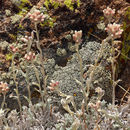en
names in breadcrumbs


Antennaria rosea is taxonomically confusing; it includes agamospermous microspecies that have been recognized as distinct taxonomic species. Morphometric and isozyme analyses have demonstrated that the primary source of morphologic variability in the complex derives from six sexually reproducing progenitors, A. aromatica, A. corymbosa, A. pulchella, A. microphylla, A. racemosa, and A. umbrinella (R. J. Bayer 1989b, 1990b, 1990c). Additionally, three other sexually reproducing species, A. marginata, A. suffrutescens, and A. rosulata, may have contributed to the genetic complexity of the A. rosea complex (Bayer 1990b). Here, four reasonably distinct subspecies are recognized within the complex.
Antennaria rosea is a North American species of flowering plant in the family Asteraceae known by the common name rosy pussytoes.[4] Other common names include cat's foot and mountain everlasting.[5] The second part of its scientific name, rosea, is Latin for pink.[6] It is widespread across much of Canada including all three Arctic territories, as well as Greenland, the western and north-central United States, and the Mexican state of Baja California.[7][8]
Antennaria rosea is a plant of many habitats, from dry to wet climates and low elevation to very high. It is a very morphologically diverse species; individuals can look very different. It is polyploid and exhibits apomixis; most all the plants are female and they reproduce asexually.[9][4]
This herbaceous perennial grows to a height of 10 to 40 centimeters (4 to 15+1⁄2 in). It has a network of short stolons by which it spreads, its method of vegetative reproduction. It forms a basal patch of woolly grayish leaves 1 to 4 cm long. Blooming early in summer,[10] the inflorescence contains several flower heads in a cluster. Each head is lined with wide, pointed phyllaries which are often rose in color, the trait that gives the species its name, but they may also be white, yellowish, or brownish. The species is dioecious, but since most of the individuals are female, most bear flower heads containing pistillate flowers. The fruit is an achene with a body less than 2 millimeters long and a pappus which may be 6 or 7 mm long. The plant often produces fertile seeds, but most individuals in most populations are clones.[11] Plants are sometimes fertilized with pollen from other Antennaria species, which may bring new genes into an A. rosea population, increasing the genetic diversity amongst the clones.[11][4]
In the UK Antennaria rosea has gained the Royal Horticultural Society's Award of Garden Merit.[5]
Antennaria rosea is a North American species of flowering plant in the family Asteraceae known by the common name rosy pussytoes. Other common names include cat's foot and mountain everlasting. The second part of its scientific name, rosea, is Latin for pink. It is widespread across much of Canada including all three Arctic territories, as well as Greenland, the western and north-central United States, and the Mexican state of Baja California.
Antennaria rosea is a plant of many habitats, from dry to wet climates and low elevation to very high. It is a very morphologically diverse species; individuals can look very different. It is polyploid and exhibits apomixis; most all the plants are female and they reproduce asexually.
This herbaceous perennial grows to a height of 10 to 40 centimeters (4 to 15+1⁄2 in). It has a network of short stolons by which it spreads, its method of vegetative reproduction. It forms a basal patch of woolly grayish leaves 1 to 4 cm long. Blooming early in summer, the inflorescence contains several flower heads in a cluster. Each head is lined with wide, pointed phyllaries which are often rose in color, the trait that gives the species its name, but they may also be white, yellowish, or brownish. The species is dioecious, but since most of the individuals are female, most bear flower heads containing pistillate flowers. The fruit is an achene with a body less than 2 millimeters long and a pappus which may be 6 or 7 mm long. The plant often produces fertile seeds, but most individuals in most populations are clones. Plants are sometimes fertilized with pollen from other Antennaria species, which may bring new genes into an A. rosea population, increasing the genetic diversity amongst the clones.
In the UK Antennaria rosea has gained the Royal Horticultural Society's Award of Garden Merit.
Subspecies Antennaria rosea subsp. arida (E.E.Nelson) R.J.Bayer Antennaria rosea subsp. confinis (Greene) R.J.Bayer Antennaria rosea subsp. pulvinata (Greene) R.J.Bayer Antennaria rosea subsp. rosea